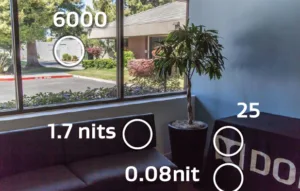Shane Mario Ruggieri, a Production Engineer, Producer and Colorist at Dolby Laboratories presented a paper titled, “Breaking out of the 100-nit Box – A Colorist’s View of HDR Grading.” In the talk, he explained that the 100 cd/m² box is a physical constraint, a standards constraint and a mindset constraint. To break out of this box, his personal journey began in 2010 with a 600 cd/m² Dolby mastering monitor. He quickly evolved to mastering on the 4000 cd/m²/P3/PQ Pulsar monitor. For the first time, RAW footage was not “flat” and the full dynamic range was visible. This created new opportunities and challenges as a colorist concerning the creative decisions that could, or should now be made. It was now possible to switch between very bright and very dark scenes or vise versa taking advantage of the viewers inability to adapt to the rapid change – just like in real life. But should you do that?
Ruggieri soon realized he was stuck in the 100 cd/m² box: he knew how skin should look and feel within this box, but not at much higher luminance levels. As a result, he went into the real world and began measuring luminance levels and light ratios to better understand their look in various situations. Notice where there is a high APL, black levels are very high compared to our current portrayal of them. Brightness levels dwarf what we can display on today’s TVs. Even a factor of 10x over SDR, 1000 cd/m², is low by these measurements corresponding to low midtones in many cases.
Some of his results are shown in the photo and bullets below.
- Skin in sun measured +9,000 cd/m² compared to 50-70 cd/m² for an SDR grade
- Skin in shadow measured +250 cd/m² compared to ~3-20 cd/m² for an SDR grade
- Shadows at +200 cd/m² reaching over 600 cd/m² compared to around ~1 cd/m² for an SDR grade
Ruggieri then began to note how he physically reacted to these variations in light and how that might help transcend to an HDR grade using the Pulsar monitor. With peak luminance of 2500 cd/m² and above, he was able to start to recreate the feeling – not the actual light levels of specific scenes. – CC

